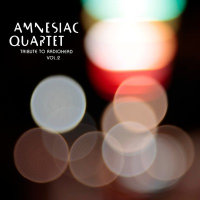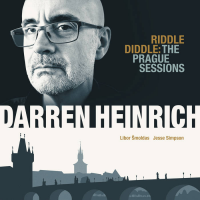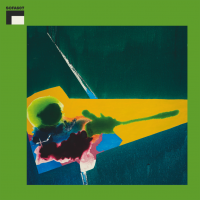Home » Jazz Articles » Album Review » Nora Germain: Let It Rip!
Nora Germain: Let It Rip!
Good memory, eh? Remember jazz violin, that four-stringed instrument that was bowed and tucked under the musician's chin, not stood on end?
Jazz violin is a tradition which has faded to such a degree that it's become necessary to invoke names of famous forebears to remind one that it ever existed. Challenge a listener to name a violinist besides the great Jean-Luc Ponty, and you're likely to get a blank stare. Yet there are giants who have been among us for many years—Mark O'Connor and Regina Carter, Ponty's jazz/rock contemporary, Jerry Goodman—not to mention lesser known players like Mat Maneri and Mark Feldman, or hard-working session man Charles Bisharat.
Legendary names like Ray Nance, Stuff Smith and Svend Asmussen elicit oohs and ahs from anyone knowing the Swing Era (when jazz was America's pop music); Joe Venuti or Clarence Black for anyone who's heard a recording of Jelly Roll Morton. Even fans with educations beginning at bebop know the name of Stephane Grappelli, though, whose work with guitarist Django Reinhardt carved both their faces into Mt. Rushmore while Dizzy Gillespie was still in grammar school—they are their own history lesson. But it takes a good memory.
Now for the good news: the tradition is still alive.
In a world that rewards bland re-formulations of the standard repertoire, where the unemotional safety of airy knob-twisting and academic chamber jazz often wins the desperate record company's big contracts, Nora Germain passionately wears her heart on her sleeve (like many violinists) and stands out in the crowd. Her standard is that the music needs to move, have impact, uplift.
And though she's an old soul, she just turned 22 and is wrapping up her college career at USC's Thornton School of Music (with bop guitarist Bruce Forman, among others). Curiously, if you were to ask her what has been the most important influence in her musical development, she'll tell you without hesitation it was the high school program at Idyllwild Arts Academy, created by Marshall Hawkins, a Washington, D.C. bassist who recorded with Shirley Horn and toured with Miles Davis, before relocating in southern California and becoming a teacher.
"There wasn't anything in my life that didn't change after I met Marshall. He taught us to express ourselves in the moment, that whenever a musician is performing, they always have whatever is needed to blow away the audience. Any musician does, regardless of background, education, age, race, training or experience. It's about the energy and energy transference."
It certainly is.
Good energy, the kind that not only lights up the room, but fires up the listener. Appropriately enough, her debut EP is entitled Let It Rip!, and that she does.
Recording artists often fret over which track to open a CD with. It has to have drama and drive, and in one fell swoop summate the energy and concept of the entire album in such a way that it induces the listener to keep on listening. "Daphne," the Django Reinhardt tune, delivers in a big way. It comes out of the chute like the first calf in a roping contest, then tears around the ring with the kind of charged-up bounce and rambunction that doesn't stop for air until the last note fades. With the pumped-up support of bassist Jon Alvarez (a fellow student from across town at UCLA), the young violinist pushes the proceedings at a frantic pace that challenges the attentions and skills of guitarist John Storie right from the start. Storie, who plays with the New West Guitar Group and has performed with Sara Gazarek, Renee Olstead and others, provides the kind of collaborative sensitivity that draws out, entertains and encourages an inventive player like Germain. Comparisons to the legendary Grappelli/Reinhardt duets are inevitable, if not with this recording, soon enough.
"Willow Weep for Me" is called a standard for a reason: written by Ann Ronell and dedicated to George Gershwin (whose conductor, Paul Whiteman, was one of the first people to record it in 1932), it has been covered by everyone from Billie Holiday and Art Tatum to Frank Sinatra, Nina Simone, Barbara Streisand and Diana Krall, and all points in between. If you were alive and listening to radio before the Telecommunications Act of 1996, hearing the melody line is like hearing the voice of an old friend on the phone. But this time the old friend probably sounds a little sweeter, a little healthier and jumps a whole lot more—beginning with Germain's pizzicato intro as she picks and bends the melody like a guitar line. The arrangement also has a bass part that is much more adventurous than on the other tracks, and we get to hear Alvarez play a fine, languid solo that keeps the time loose and lyrical, and helps Germain and Storie sway and roll as though the three of them are sitting in a porch swing, buffeted by a summer breeze.
"I Got It Bad," a.k.a. "I Got It Bad (And That Ain't Good)," the classic Duke Ellington/Paul Francis blues about unreciprocated longing, is a chance for Germain to unleash the emotionality of her solo voice on this centuries-old instrument whose sonorities, perhaps more than any other instrument's, were designed to evoke the soaring extremes of rapture and rending pain that can overpower someone caught between devotion and surrender. John Storie's gently rhythmic guitar eases the listener into the tune while Germain's fluid expression begins building and releasing tension from the opening phrases, as clearly as if she were speaking, eliciting conversational responses from Storie while Alvarez's bass cushions and steadies. As the violinist reaches higher and higher, there is no room for noodling while she rapidly finds and executes the delicate ideas that unfold, her arrangement allowing for improvising on the fly, far ahead of her fingers. There were likely many rehearsals in anticipation of this first recording, but the lines she teases and draws from the strings are immediate, the impact intense.
Charlie Parker's "My Little Suede Shoes" has a catchy melody that once again has Germain and Storie making the old and familiar into something of their own as they trade phrases and swing on top of Alvarez's bouncing bass, like the earlier page taken from the Stéphane Grappelli/Django Reinhardt oeuvre on "Daphne." Also like that tune, the arrangement's telegraphed coda manages to promise a neat ending that has all the swirling components land in a tidy heap in the right spot—and then it doesn't. Like "Daphne," the saucy cadenza at the end repeats the phrase with a twist, repeats again with another, then ends on a smart, bright, but unexpected note.
This is well-crafted, deceptively simple-sounding but enormously satisfying music. It is made not to cajole or provoke long discussions or invite algorithmic analysis, but to make the listener smile. Of course, when you see it show up on a future Blindfold Test, you'll remember that you saw it here first.
Jazz violin is alive and well.
Tags
Nora Germain
Extended Analysis
Carl L. Hager
Self Produced
United States
Jean-Luc Ponty
Regina Carter
Mat Maneri
Mark Feldman
Charlie Bisharat
Stephane Grappelli
Django Reinhardt
bruce forman
Marshall Hawkins
Shirley Horn
Miles Davis
John Storie
Sara Gazarek
Renee Olstead
Billie Holiday
Art Tatum
Nina Simone
duke ellington
Charlie Parker
Nora Germain: Let It Rip!
PREVIOUS / NEXT
Support All About Jazz
 All About Jazz has been a pillar of jazz since 1995, championing it as an art form and, more importantly, supporting the musicians who make it. Our enduring commitment has made "AAJ" one of the most culturally important websites of its kind, read by hundreds of thousands of fans, musicians and industry figures every month.
All About Jazz has been a pillar of jazz since 1995, championing it as an art form and, more importantly, supporting the musicians who make it. Our enduring commitment has made "AAJ" one of the most culturally important websites of its kind, read by hundreds of thousands of fans, musicians and industry figures every month.

















